Acer Aspire S7 Ultrabook: Acer’s Best Foot Forward
by Jarred Walton on January 7, 2013 4:30 AM EST- Posted in
- Laptops
- Acer
- Intel
- Ivy Bridge
- Aspire S7
- Ultraportable
- Ultrabook
Battery Life and Thermals
With the performance aspects out of the way, let's turn to battery life. I have to say, I've run more battery tests on the Acer S7 than perhaps on any other laptop in recent history. It's not that it needed extra testing, but as the first Windows 8 laptop in our labs I wanted to look at changing some of the tests. We discussed things among the various editors, and I worked to come up with some redesigned, hopefully better battery life tests.
First on the chopping block is the idle battery life test; rarely do people use workloads that are so light that it's meaningful to look at pure idle battery life, and going to the extreme of muting the volume and turning off WiFi is more than most are willing to do. We've decided to move to our Internet test as the baseline measurement, since it's representative of a moderate workload that conceivably might be used while running a laptop on battery power. With moderate Internet surfing (we load four pages every minute, simulating time for reading) as our light workload, for our heavy workload we crank up the frequency of page loads (the same pages, only loading every 10 seconds now) and add in playback of a bunch of 128kbps MP3 audio files. Finally, for our heavy workload we keep the Internet portion of the moderate testing but add in looped playback of a 1080p H.264 encoded video and have a constant 1Mbps download running from a local server.
With this being the first laptop to use our new Windows 8 test suite, we're in a bit of a state of flux so I've run both the new battery tests along with the old Windows 7 era tests (only with IE10 instead of IE8/9). I also ran a few other battery life tests just for reference: the three PowerMark tests. We're a little hesitant to use PowerMark as a standard, simply because it's limited to Windows platforms and has the potential to encourage optimizations for a benchmark as opposed to general optimizations; as you'll see, however, there's plenty of overlap between our tests and the results from PowerMark.
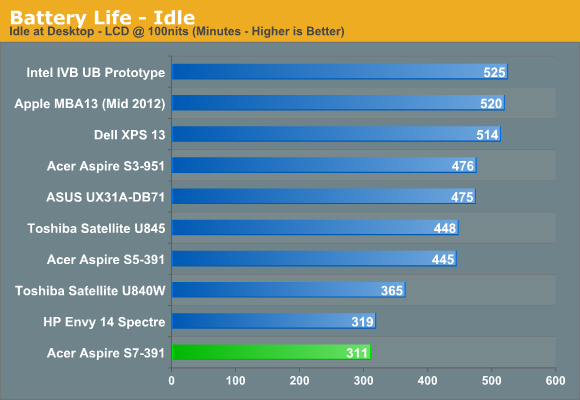
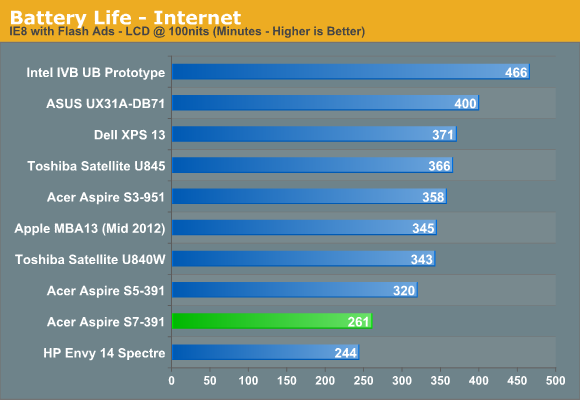

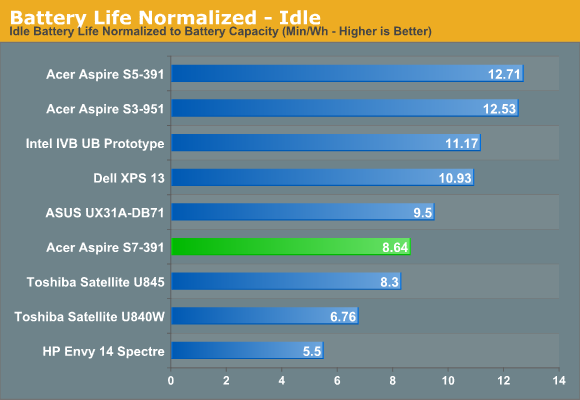
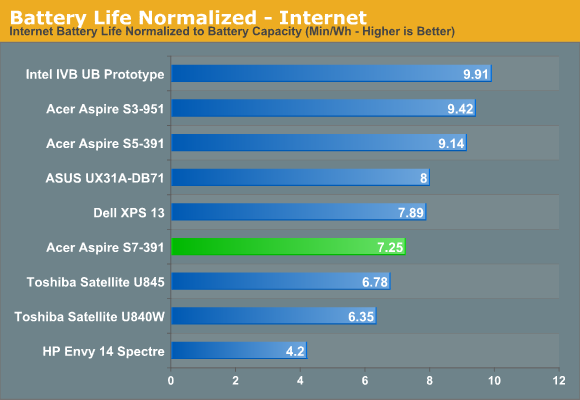
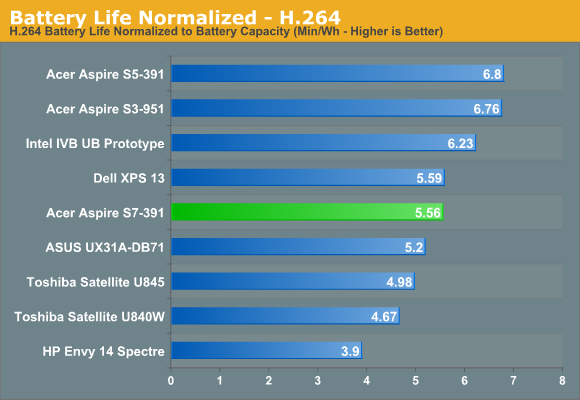
Starting with our older 2012 battery benchmarks, the Aspire S7 has a pretty poor showing. The 35Wh battery is the same capacity as the previous generation Aspire S5, and yet battery life is down substantially in all three tests. Whatever Acer (or Microsoft) has done in the past six months has not been helpful in this area. Normalizing for battery capacity does improve the situation a bit, but where it’s enough to move Acer past the two Toshiba Ultrabooks and the HP Envy 14, that’s not saying a lot—and higher battery capacities do count for something. The bottom line is that best-case, we were able to get just over five hours of running time out of the Aspire S7. Let’s look at some other results.
| Acer Aspire S7 Additional Battery Tests | ||
| Battery Test |
Run Time (Minutes) |
Normalized (Min/Wh) |
| AnandTech 2013 Light | 240 | 6.86 |
| AnandTech 2013 Medium | 173 | 4.94 |
| AnandTech 2013 Heavy | 137 | 3.91 |
| PowerMark Productivity | 255 | 7.29 |
| PowerMark Balanced | 201 | 5.75 |
| PowerMark Multimedia | 172 | 4.91 |
Note that in the above tests, we’re using 200 nits for our 2013 test suite while PowerMark specifies 110 nits as their desired brightness level. Our Light test result is down 21 minutes from our previous Internet test result, most likely due to the increased LCD brightness. Elsewhere, our new Medium test drops us below the three hour mark, and our Heavy test is getting close to lasting only two hours. It’s not really realistic to expect a full day of use from a laptop when you’re going full-tilt the whole time, but considering the CPU load is only around 10-35% even in our Heavy test, we’re not pushing things that hard.










53 Comments
View All Comments
calyth - Monday, January 7, 2013 - link
Well, $500 laptop is fine for most uses, until you try to do anything that generates a lot of heat. Playing a game, converting video, etc etc.Most of the windows laptop in that range has heatsinks that copes with the average uses, but any spikes, and it would just wear out pretty quickly over time.
While MacBooks may have that aluminum frame advantage (in terms of heat dissipation), none of the current line up use anything particularly better than an Intel IGP. Getting the 650M requires $1700 bucks or more.
I don't particularly think that Acer's attempt here is bad, and Windows laptop gets close to Apple styling for more bang for the buck anyways. But for me, I kinda wish to get a decent laptop that could cope with work loads a little better, for reasonable cost, and not look like a brick (e.g. Dell Lattitudes). Thats' still not really happening.
Silma - Monday, January 7, 2013 - link
I almost purchased Acer's Aspire S7 but I didn't in the end because of the following shortcomings which are often shared by all PC manufacturers:- Acer, who do you think you are, mutilating the keyboard for no good reason?
- Battery. I would prefer a 1 or 2mm thicker Ultrabook any day for a (replaceable) decently sized battery, e.g. 70 Wh or more.
- Cooling and noise. Please add value, don't be an assembler and work harder on cooling and noise. Most owner reviews complain about both.
- Soldered memory. If you absolutely want to solder memory instead of making it upgradable, then you need to offer 8 GB at the very least, especially at this super premium price. Even better offer an Ultrabook with upgradable memory.
- Non replaceable SSD. Again, for a super-premium laptop, one should expect at least 3 years of usage, which means upgrading the SSD down the road.
It is really a shame as the following points made the Aspire S7 extremely endearing:
- Kudos for the choice of a touch-enabled, full HD and IPS panel, which makes this screen 3x better than most offering (hall of shame: Lenovo X1 Carbon super crappy screen at $1.5k +)
- Kudos for the aesthetic. It won't please all people, but at least it went further than most manufacturers
- Kudos for the very decent computing power.
DanNeely - Monday, January 7, 2013 - link
I've seen speculation elsewhere that it's the touchscreen that are responsible for the poorer battery life seen in w8 laptops vs their w7 ancestors; but I haven't seen anyone try to confirm this by disabling it and rerunning any of the battery tests.CadentOrange - Monday, January 7, 2013 - link
We've established that they're gunning for Macbook air prices, but other than that is it really comparable?How does the keyboard feel? I've seen the keyboard panned in the Ars review, and I tend to agree with them. If I'm spending $1500 on a laptop, I'd like a keyboard that doesn't feel clobbered together. Where are the function keys? Why is there no space between the "\" key and "Enter"? Does that annoy in practice?
The battery life is abysmal. If you're going to charge as much as an Air, you really should perform like an Air. I'm no Apple fanboy, I have a 2nd hand Macbook and all my other PCs and server run Linux. It's in my interest that PC manufacturers produce products that rival Apple's. This is sadly not even close.
KPOM - Monday, January 7, 2013 - link
Compared to the 13.3" MacBook Air with 256GB, which retails for $1499 with the 1.8GHz i5 and $1599 with 2.0GHz i7, the Asus has a better display (1920x1080 IPS touchscreen vs 1440x900 TFT non-touch), a processor that splits the difference, and lighter weight. Battery life is a bit disappointing, but overall it looks like a competitive package. The challenge is that PC buyers aren't used to paying these kinds of prices. The quality appears to be there (though the keyboard discussion is a bit worrying).ananduser - Monday, January 7, 2013 - link
The machine reviewed is an Acer not an Asus.Death666Angel - Monday, January 7, 2013 - link
Those are the things I would like to see. I don't want RAID 0, the battery needs to be bigger for me (and I don't care that much about height, so make it 2cm and double the capacity or something) and 4GB of RAM are a joke in this day and age. The rest looks fine enough. :)Tech-Curious - Monday, January 7, 2013 - link
Yeah, the RAID and the RAM are the dealbreakers for me -- and perhaps amusingly, those are the two cheapest things to fix. Switch off RAID and instantly the value proposition of the storage system is doubled. As for the memory, yeah; my old Clevo laptop's 4GB of RAM was impressive back in early 2008. Now, not so much. C'mon Acer, spring for 8GB.Those two changes represent maybe $30 of extra cost in parts, but they'd increase the perceived value of the whole product by $200-300, IMO, and maybe more to the general consumer.
I wonder how much money Acer would save by swapping out the touch screen. :)
Death666Angel - Monday, January 7, 2013 - link
I would like to meat the person who made those 2 decisions and get their explanation for it. With graphics cards, companies/marketing brag about 3GB on a GT630 or something, but with many Ultrabooks, they don't deliver even though the added cost is likely to be very low.Also, the missing F-Keys is not very nice. I don't use them super frequently, but they do add to my productivity in certain scenarios and it looks like they would have fitted on the laptop easily.
And lastly, I just ran Kraken on my desktop PC (i7 860 which is quite old by PC standards): 2515.1ms +/- 2.7%... didn't expect that much to be honest. :)
Death666Angel - Monday, January 7, 2013 - link
And my Galaxy Nexus manages 25,728.6ms /+-11.9%. That is strange.